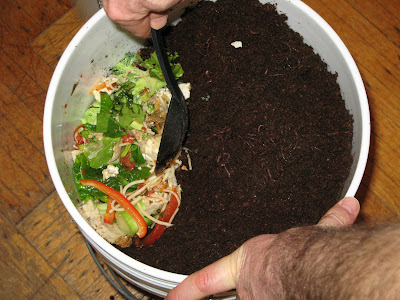
The compost bin is comprised of 2 large, plastic paint buckets, a shower drain hair catcher, a hot tin can, an SOS pad, tape, peat moss and sand.
The concept is shown at the top of the page where my husband is gathering the finished compost. (That stage will be described later.) But basically, the worms live in the peat moss. The peat moss sits above a layer of sand that prevents the worms from burrowing further towards the bottom of the bin (and thereby drowning in the drainage water etc) The shower hair catcher sits in a hole in the bottom of the worm's home beneath the sand to allow excess fluids to drain into the second bucket. The two buckets are stacked, one in the other, with the second bucket acting as the "liquid gold" catcher. This liquid does amazing things on house plants, or if you are short on greenery, it can be poured down the toilet.
How many bins should you make? One is a nice start :) but it probably won't use all of your scraps, depending on your cooking style and frequency. As a vegetarian family of 3 (2 adults, one child) that cooks 5-6 nights a week from scratch, plus most breakfasts and eats leftovers for lunch, 6 bins is about perfect to utilize all of our scraps. Gauging it is difficult, but its always really easy to make one or two more bins down the line...













